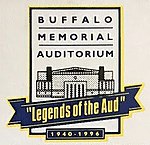
Back قاعة بافالو التذكارية Arabic Buffalo Memorial Auditorium Czech Buffalo Memorial Auditorium German Buffalo Memorial Auditorium French Buffalo Memorial Auditorium Italian 버펄로 메모리얼 오디토리움 Korean Buffalo Memorial Auditorium SIMPLE
"The Aud" | |
 | |
 Aerial view of the venue (center) in October 2007. 2 years before demolition | |
 | |
| Address | 140 Main Street |
|---|---|
| Location | Buffalo, New York |
| Coordinates | 42°52′41″N 78°52′39″W / 42.87806°N 78.87750°W |
| Public transit | |
| Owner | City of Buffalo (1940–2007) Erie Canal Harbor Development Corporation (2007–2009) |
| Operator | City of Buffalo |
| Executive suites | 16 |
| Capacity | Hockey: 16,325 Basketball: 18,000 |
| Record attendance | Overall: 21,000 Ike Eisenhower rally, 10/23/1952 John F. Kennedy rally, 9/28/1960 Sports: 19,226 Braves vs. Celtics, 1/31/1976 |
| Field size | 350,000 sq ft (33,000 m2) |
| Construction | |
| Broke ground | November 30, 1939 |
| Opened | October 14, 1940 |
| Renovated | 1970, 1990 |
| Expanded | 1970 |
| Closed | September 11, 1996 |
| Demolished | April 2009 |
| Construction cost | US$2.7 million ($58.7 million in 2023 dollars[1]) |
| Architect | Green & James |
| Tenants | |
| Canisius Golden Griffins (NCAA) 1940–1995 Buffalo Bisons (AHL) 1940–1970 Buffalo Bisons (NBL) 1946 Buffalo Braves (NBA) 1970–1978 Buffalo Sabres (NHL) 1970–1996 Toronto-Buffalo Royals (WTT) 1974 Buffalo Stallions (MISL) 1979–1984 Buffalo Bandits (MILL) 1992–1996 Buffalo Blizzard (NPSL) 1992–1996 Buffalo Stampede (RHI) 1994–1995 | |
Buffalo Memorial Auditorium, colloquially known as The Aud, was a multipurpose indoor arena in downtown Buffalo, New York. Opened on October 14, 1940, it was home to the Canisius Golden Griffins (NCAA), the Buffalo Bisons (AHL), the Buffalo Bisons (NBL), the Buffalo Braves (NBA), the Buffalo Sabres (NHL), the Toronto-Buffalo Royals (WTT), the Buffalo Stallions (MISL), the Buffalo Bandits (MILL), the Buffalo Blizzard (NPSL) and the Buffalo Stampede (RHI). It also hosted events such as college basketball, concerts, professional wrestling and boxing. The venue was closed in 1996 after the construction of the venue now known as KeyBank Center, and remained vacant until being demolished in 2009.
- ^ 1634–1699: McCusker, J. J. (1997). How Much Is That in Real Money? A Historical Price Index for Use as a Deflator of Money Values in the Economy of the United States: Addenda et Corrigenda (PDF). American Antiquarian Society. 1700–1799: McCusker, J. J. (1992). How Much Is That in Real Money? A Historical Price Index for Use as a Deflator of Money Values in the Economy of the United States (PDF). American Antiquarian Society. 1800–present: Federal Reserve Bank of Minneapolis. "Consumer Price Index (estimate) 1800–". Retrieved February 29, 2024.